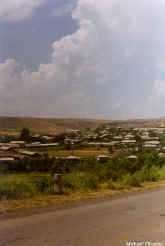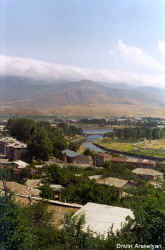|

|
A stone-built checkpoint/bus stop marks the right turn from the main Goris
road toward Sisian. From
the Sisian road, turn right into
Shaki, then left at the village center, jog right,
and left again, to follow a dirt road that leads to a small
tributary of the Vorotan which joins the main stream
via a small (because diverted to
a hydroelectric plant) but
attractive
|
|
Sisian
(Gharakilisa
till 1935, then Sisavan till 1940) is a pleasant town
at the confluence of the Vorotan and Sisian rivers. The
history museum has on display 2nd millennium BC
pottery and other finds from the Bronze Age cemetery/“observatory”
of Zorakarer
N of town. In
the museum garden are a series of medieval
sheep-shaped
tombstones, some
with Persian
|

|
|
waterfall. Near the village are the ruins of
Shaki Vank, and a
shrine
with khachkars. According
to legend, the site was named for Shake, one of 93 maidens saved from
flood by a miracle.
|
|
inscriptions
perhaps a testament to the presence of Turkmen
tribes in the region in the 15th through 18th centuries. The road uphill
from the prominent Soviet monument to those who fell in 1921 during the
Sovietization of Zangezur (leads to a
cemetery to Sisian’s Karabakh martyrs, and from there to the
Sisavan
church, also known as S. Hovhannes or Syuni Vank. The church was built by Prince Kohazat and Bishop Yovsep I
between 670 and 689, and restored in the 19th and 20th
centuries. There are
sculpted reliefs of the builders somewhere on the church. On the E side of
Sisian, a princely tomb of the 2-1st
c. BC contained rich grave goods. On
the plateau east of town is a large Middle Bronze through Early Iron Age
cemetery.
Leaving
Sisian on the road NNE from the center of town, climb up the hill, then
turn hard left where you see the rusting
steel umbrellas. This
road will lead you in a couple of km to Zorakarer, Bronze
Age settlement/cemetery
site left of the road, around whose large chamber tombs are a series of
standing stones, some with holes pierced in them.
It is universally assumed that this is an early astronomical
observatory, though the alignment is not ideal for the purpose. In any case, the site is beautiful and ancient, well worth the
visit. Most of the volcanic
caves near the city
were used by people starting from the stone age. |